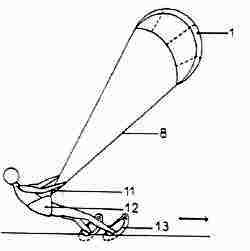   |
||
|
THE BIRTH OF THE MARINE WING
Dakar May 1984 The first kite stack using the Jacob's Ladder effect. Bruno launching the stack
To take off this stack, a one meter long control bar with line reels was built
They attended their first Brest Speed Sailing Week in April, 1985, winning the Innovation Award, and attended two others in 1986
|
|
The first tests were made with boards but the kite stacks were so difficult to launch that they found water skis easier.
First high speed sailing with a single inflated wing and skis. October 1984
Their goal was to get an R & D and manufacturing arrangement with sailboard sail manufacturers, but the time was not right. The sailboard market was at its peak and everybody considered windsurfing as the ultimate in sailing.
At that time, their kites were just prototypes. They couldn't go upwind with skis or boards, so they worked for years on skis, boards, boats and kites, and dabbled in several other ideas, looking for a market. |
It was possible to ski in 5-6 knots of wind, with the limiting factor being the ability to relaunch the wing. A long search and dozains prototypes later the stability problem had been solved by 1988-89. The refined design was also of lighter, single skin construction; much easier to launch and control. The kite was almost ready for production, but they still had not found skis or a board able to go upwind. Sure, they had made at least 10 boat prototypes with good upwind ability, but they were either too large, too heavy or too costly, bearing in mind that they had a design target of under two metres in length and less than 10 kg in weight. Attached to the front beam of a 3m rigid catamaran,
|
|
A small selection of the Legaignoux's prototypes
In 1985 and 86 they built their most efficient wings, with a very high aspect ratio and completely double skinned. But they were heavy, especially when wet. Worst of all, they were so unstable that just keeping the kite flying required a great deal of effort..
All photos are © copyright WIPIKA, D&B Legaignoux. |
